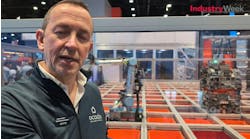What a difference two years make. It’s been that long since the North American material handling and logistics industry has had an in-person trade show to showcase all the latest developments in supply chain technology. In fact, it was during day 3 of MODEX 2020 in Atlanta when the global pandemic was officially declared, and it’s hard to forget those images of an exhibition center—which was already half-empty due to numerous cancellations and early exits—basically just rolled up the carpets as the few remaining attendees decided to call it a day... or as it turned it, two long years.
Back in 2020, it was still considered trendy to refer to various supply chain technologies as “disruptive,” which back then meant they had the capabilities to help companies gain a competitive advantage over their peers. Today, of course, “supply chain disruptions” has taken on an entirely different meaning, signifying the varied and numerous failures companies—and their customers—have experienced in getting products made and delivered in anything remotely resembling a timely fashion.
In fact, according to the 2022 MHI Annual Report (produced in collaboration with Deloitte Consulting), the number one challenge for companies today is supply chain shortages and disruptions, according to a survey of over 1,000 supply chain and manufacturing leaders. Prior to 2022, the number one challenge had been hiring and attaining qualified workers for the past eight years of the survey, which is now in its ninth year.
As companies still struggle with supply chain shortages that were caused, in part, by the global pandemic and now seem to have taken on a life of their own, it’s only natural that automation and supply chain technologies would emerge as a way to produce and transport products quicker, while easing the reliance on human labor to get the jobs done. In fact, according to John Paxton, CEO of MHI (the trade association that hosted the recent MODEX 2022 trade show in Atlanta), the survey indicates that 87% of respondents believe the pandemic has accelerated the strategic importance of supply chain operations.
Thomas Boykin, supply chain specialist leader with Deloitte Consulting, who joined Paxton in a MODEX 2022 keynote panel discussion focusing on the annual report results, pointed out that 66% of respondents say their companies will spend more than $1 million over the next two years on supply chain technologies. Of that group, 41% say they’ll spend more than $5 million, and another 18% say they’ll spend more than $10 million.
Where will that money be spent? The survey says it’ll most likely on inventory and network optimization tools, according to 87% of respondents. Other technologies with at least an 80% response rate as being adopted within the next five years include: cloud computing and storage (86%), sensors and automatic identification (84%), predictive and prescriptive analytics (82%), and the industrial Internet of Things (80%).
It’s probably wise not to take those predictions of future spending at face value, though. Five years ago, in the 2017 MHI Deloitte Annual Industry Report, only 15% of respondents had adopted 3-D printing, but nearly half (49%) of all respondents planned to adopt the technology within 3-5 years, which at the far end of that timeframe would be right now. However, in the 2022 report, the percentage of 3-D printing adoptees had barely budged, climbing to just 18%; another 68% say that within five years they’ll be uses of additive manufacturing technology, but at this point it seems more of a guess than a realistic estimate of adoption plans.
Similarly, other technologies such as artificial intelligence, drones and blockchain, have been predicted for years to become “disruptive” and “game-changers” for the past five years or so, but none has even cracked the 20% range for adoption; nevertheless, the predictions (or to put it another way, the hope) is that all of these could be in regular usage by 2027 at two-thirds of the respondents’ companies. We shall see.
The good news is that total attendance at MODEX 2022 came it at just over 37,000. (Not sure if those numbers include the exhibitors, but even if it does, that's a lot of people). According to MHI, that's the best-attended MODEX event ever, which bodes well for next year's PROMAT show in Chicago, which historically has been an even bigger show than MODEX.
What's the ROI of Doing Nothing?
One of the newer supply chain technologies that didn’t even make the list of most-likely-to-adopt but that nevertheless holds a lot of promise is digital twins. “Leading companies are applying the concept of digital twins, long used to simulate finite manufacturing operations, to build digital models of entire supply chain networks and ecosystems,” Boykin explained in the annual report. “These digital supply chain twins can be used like gaming platforms to simulate and evaluate short- and long-term structural and strategic moves, helping companies increase resiliency and navigate future uncertainty.” Supply chain simulation using digital twins can help companies better leverage their analytics tools and data.
“Developing a robust digital twin is really hard work,” noted Terry Esper, associate professor of logistics at The Ohio State University, one of the participants in the MODEX 2022 panel discussion. “We see the benefits theoretically, but getting there is very difficult. Businesses are increasingly risk-averse, so if they can develop better analyses and models, digital twins may become more heavily adopted as a tool.”
Logistics giant DHL has been using simulation models for a while, pointed out Adrian Kumar, global head of operations science and analytics with DHL Supply Chain, “but we need to get better at it. Making sure something is going to work before you put it into operation can be of great benefit.” DHL is committed to spending $300 million on various innovative technologies.
Added Jason Minghini, group vice president operations with third-party logistics provider Kenco, “Lots of companies have never used automation or robots, so simulation can help them see how it would work. I think we’ll see an increase in the amount of simulation as companies turn more towards automation.”
And yet, while supply chain disruptions have become the dominant challenge in many people’s minds, Torsten Pilz, senior vice president and chief supply chain officer with Honeywell, pointed out that for his company, “The biggest problem isn’t finding semiconductors. It’s finding trained and skilled workers.”
According to Pilz, companies have historically underfinanced their supply chains, which is part of the reason why the pandemic-driven disruptions have affected so many businesses. “Senior leaders have begun to recognize the importance of the supply chain and are taking it more seriously. But it will take years to right the ship.”
Minghini agreed. “Some of the effects of the pandemic, such as the Great Resignation, are here to stay, so the competition for talent will continue.”
Finally, Boykin observed, "The biggest barrier to technology adoption is the lack of a clear business case to justify the investment.” That stumbling block consistently topped the list of every technology mentioned in the annual report, even something as widely adopted as cloud computing. “While firms have not adopted some technologies as quickly as they thought they would back in 2014 or 2015, what we are seeing now is a big jump in these investments. Where we used to say evolve or die, what we now say is transform or die.”
Esper summarized not only the annual report’s conclusions but the entire mood of MODEX 2022. “What’s the cost of not investing in supply chain?” he asked. “What’s the ROI of the business you didn’t get because you didn’t invest in supply chain?” It will be fascinating to see if the opinions expressed by respondents to the MHI report result in significant investment in the types of technologies on display at the MODEX 2022 trade show.




